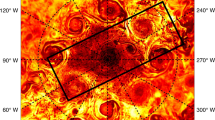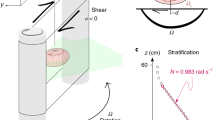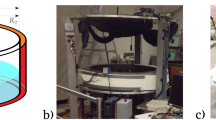Abstract
We have recently presented evidence1 supporting the hypothesis2 that the long-lived large oval atmospheric eddies on Jupiter and Saturn, including Jupiter's anticyclonic Great Red Spot (GRS) and White Ovals and the cyclonic ‘barges’, are manifestations of ‘slantwise’ or ‘sloping’ convection in a rotating fluid, implying that they are involved in the horizontal transport of heat towards or away from the edges of the atmospheric zones or belts in which they occur, and that their kinetic energy derives directly from the action of gravity on the density field associated with horizontal gradients of temperature. These eddies would then be dynamically similar to the highly stable closed ‘baroclinic’ eddies produced in certain laboratory experiments on thermal convection in a rotating fluid subject to internal heating or cooling1,3. We now present laboratory findings that bear on the interpretation of the isolated nature of the GRS, including the crucial demonstration that a single intense stable baroclinic disturbance that is strongly localized in azimuth can form readily when the impressed conditions are close to the transition from axisymmetric to non-axisymmetric flow.
This is a preview of subscription content, access via your institution
Access options
Subscribe to this journal
Receive 51 print issues and online access
$199.00 per year
only $3.90 per issue
Buy this article
- Purchase on Springer Link
- Instant access to full article PDF
Prices may be subject to local taxes which are calculated during checkout
Similar content being viewed by others
References
Read, P. L. & Hide, R. Nature 302, 126–129 (1983).
Hide, R. Observatory 100, 182–193 (1980); Met. Mag. 110, 335–344 (1981).
Hide, R. & Mason, P. J. Phil. Trans. R. Soc. A268, 201–232 (1970).
Ukaji, K. J. met. Soc. Japan 57, 532–547 (1979).
Hide, R. & Mason, P. J. Adv. Phys. 24, 47–100 (1975).
Fultz, D., Long, R. R., Owens, G. V., Bohan, W., Kaylor, R. & Weil, J. Met. Monogr. Amer. met. Soc. 4, 1–104 (1959).
Hide, R. Phil. Trans. R. Soc. A250, 441–478 (1958).
Hart, J. E. A. Rev. Fluid Mech. 11, 147–172 (1979).
Hide, R. J. atmos. Sci. 24, 6–9 (1966); Phys. Fluids 10, 56–68 (1967).
Jonas, P. R. & Kent, P. M. J. Phys. E12, 604–609 (1979).
James, I. N., Jonas, P. R. & Farnell, L. Q. J. R. met. Soc. 107, 51–78 (1981).
Gehreis, T. (ed.) Jupiter: Studies of Interior, Atmosphere, Magnetosphere and Satellites (University of Arizona Press, Tucson, 1976); Saturn: Studies of Interior, Atmosphere, Rings and Satellites (University of Arizona Press, Tucson, 1984).
Flasar, F. M. et al. J. geophys. Res. 86, 8759–8767 (1981).
Pedlosky, J. Geophysical Fluid Dynamics (Springer, Berlin, 1979).
Gill, A. E. Atmosphere-Ocean Dynamics (Academic, London, 1982).
Mason, P. J. Phil. Trans. R. Soc. A278, 397–445 (1975).
Hide, R. The Global Circulation of the Atmosphere (ed. Corby, G. A.) 196–221 (Royal Meteorological Society, London, 1969).
Author information
Authors and Affiliations
Rights and permissions
About this article
Cite this article
Read, P., Hide, R. An isolated baroclinic eddy as a laboratory analogue of the Great Red Spot on Jupiter. Nature 308, 45–48 (1984). https://doi.org/10.1038/308045a0
Received:
Accepted:
Issue Date:
DOI: https://doi.org/10.1038/308045a0
This article is cited by
-
Remote determination of the shape of Jupiter’s vortices from laboratory experiments
Nature Physics (2020)
-
Experiments to study the beta-effect in atmospheric dynamics
Experiments in Fluids (2005)
-
Experiments to study interactions between baroclinic lower flows and a stably stratified upper layer
Experiments in Fluids (2005)
-
A convective model for the zonal jets in the atmospheres of Jupiter and Saturn
Nature (1994)
-
Problems of simulation of large, long-lived vortices in the atmospheres of the giant planets (jupiter, saturn, neptune)
Surveys in Geophysics (1994)
Comments
By submitting a comment you agree to abide by our Terms and Community Guidelines. If you find something abusive or that does not comply with our terms or guidelines please flag it as inappropriate.



